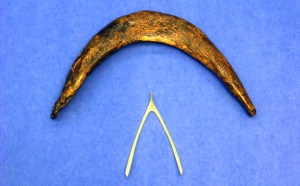 A wishbone from a theropod and a turkey.This week, many of us celebrated one of the most American of holidays: Thanksgiving. Following tradition, most of us probably had a bite or two of turkey -- if you were one of the fortunate to get your hands dirty, you may have used this New York Times video as a guide.
A wishbone from a theropod and a turkey.This week, many of us celebrated one of the most American of holidays: Thanksgiving. Following tradition, most of us probably had a bite or two of turkey -- if you were one of the fortunate to get your hands dirty, you may have used this New York Times video as a guide.
What you may not know is that we can find homologies of many birds parts -- thigh bones, arm hones, and even wishbones -- in our own skeleton, and it's not happenstance. The ultimate reason for this similarity is ancestry: birds, mammals and all other tetrapods (four-legged, air-breathing vertebrates) share a common ancestor, over 300 million years old. And, as the descendents, we all exhibit the same basic body plan, with additional anatomical refinements specific to each evolutionary history. Whether a tetrapod's arm is a fin, a wing or a limb throwing a baseball, a common structure is shared among them because of their evolutionary past.
Back to turkeys: in your holiday meal, you may have come across a very particular y-shaped bone: the wishbone. (The one from my turkey is drying on the counter above the kitchen sink). Humans actually have homologues of wishbones, but we don't call them that -- they're our collarbones, or clavicles. These bones are long and slender, and they form a key part of complex of bones and muscles that allow us to move our arms. Living birds are unique among tetrapods in having clavicles that are fused together into the y-shaped structure called a furcula, and it plays a key roles in allowing birds to fly. Furculae stiffen the thoracic skeleton, and, in conjunction with a keeled breastbone (or sternum), they provide key muscle anchors for the unique flight stroke of the bird arm.
So, how did two bones get fused into one? Birds are descended from one particular line of dinosaurs called theropods, which includes dinosaurs like T. rex or Velociraptor. Over the last 20 years, paleontologists have assembled a detailed picture of the family tree, or phylogeny, of these animals, showing the exact anatomical changes that occurred along the lineage of theropods to living birds. The changes in the furcula plays a key role in this evolutionary sequence: it turns out that relatives of T. rex and many other theropods had fused furculae, but clearly these animals did not use the fused furcula to fly. Some paleontologists have suggested that fused furculae in theropods increased the mobility of the forelimbs. Then, as birds evolved flight, a fused furcula turned out to be wonderfully useful as a brace for a flapping limb.
Evolution often works in this manner: recruiting old structures to use in a new context, and many examples of such improvisation have been shown in the fossil record. Together, phylogeny and the fossil record reveal more about evolution that might not have been apparent when you were first biting into that savory chunk of turkey meat. To check find out more about your holiday dinosaur, check out this link too.
